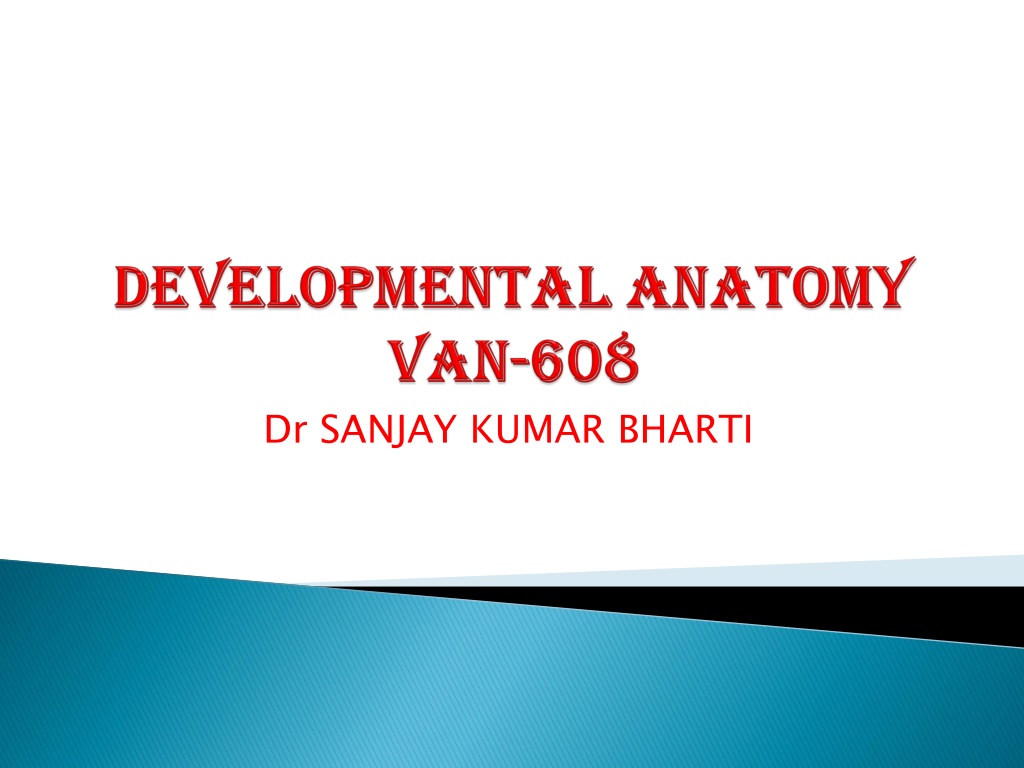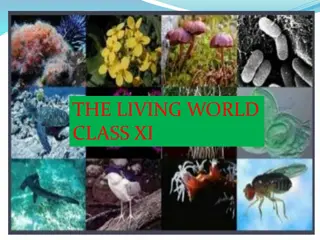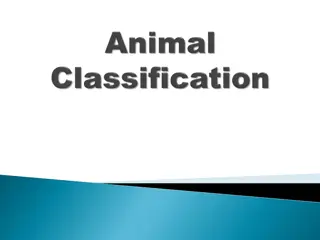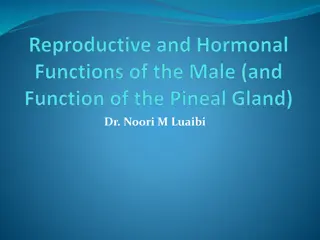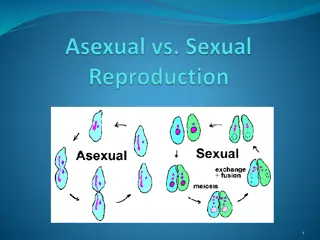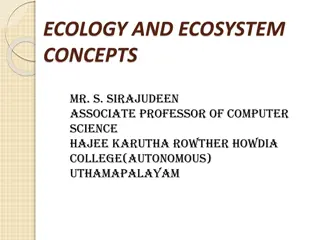Understanding Gametogenesis and Spermatogenesis in Living Organisms
Gametogenesis is a vital process in living organisms where germ cells develop into gametes for reproduction. Spermatogenesis, specifically in males, involves phases like multiplication, growth, and maturation to produce sperm. This intricate process ensures the perpetuation of species through the formation of essential reproductive cells. Understanding these processes sheds light on the remarkable ability of organisms to reproduce and continue their lineage.
Download Presentation

Please find below an Image/Link to download the presentation.
The content on the website is provided AS IS for your information and personal use only. It may not be sold, licensed, or shared on other websites without obtaining consent from the author. Download presentation by click this link. If you encounter any issues during the download, it is possible that the publisher has removed the file from their server.
E N D
Presentation Transcript
GAMETOGENESIS The most important characteristic of every living organism is the ability to reproduce to perpetuate the species. The reproductive cells, which unite to form the new individual, are known as gametes. In all higher vertebrates, the gametes from male are called spermatozoa and the larger, food laden gametes formed within the female are termed ova/ovum. The gametes themselves and the cells that give-rise to them constitute the germplasm of an individual. The other cells of the body, which take no direct part in the production of gametes, are called somatic cells. The process by which the gametes are produced is known as gametogenesis.
GAMETOGENESIS It includes Spermatogenesis in male Oogenesis in female. Generally, gametogenesis is divided into four major phases Origin of germ cells and their migration into gonads. The multiplication of germ cells by mitosis. Reduction division/Meiosis. The final stage of maturation and differentiation of the gametes into spermatozoa/ova
SPERMATOGENESIS The development of sperm in the testes is called spermatogenesis. The testis is a glandular organ composed of several coiled seminiferous tubules and their wall is formed by a multi- layered epithelium called germinal epithelium. The germinal epithelium is formed by two types-spermatogonia, primary spermatocyte, secondary spermatocyte and spermatids. When the male animal becomes spermatogonia begin to produce sperms. This process includes three phases. Multiplication/Mitotic Phase. Growth Phase Spermatogenesis/Maturation Phase. sexually mature, these
SPERMATOGENESIS Multiplication phase Mitosis of spermatogonia occurs throughout the life and they are situated near the outer wall of the seminiferous tubules. The spermatogonia are the rounded cells and they are the mother cells from which primary spermatocyte are produced. These are also rounded cells situated near to the spermatogonia. Growth phase During this phase, limited growth occurs. This growth phase is insignificant.
SPERMATOGENESIS Maturation phase Each primary spermatocyte is divided into two secondary spermatocyte by I meiotic division. From each of the secondary spermatocytes, two spermatids are produced by II meiotic division. Thus from one primary spermatocyte four spermatids are produced. The spermatids do not divide any more. Each spermatid is gradually transformed into a fully formed, potentially functional male gamete, the spermatozoa. This final phase ofspermatogenesis where spermatogenesis does not begin until puberty but is then continues throughout life. The transformation of the spermatid into mature spermatozoa is known as spermiogenesis.
SPERMATOGENESIS During the spermatogenesis the following changes occur; The nucleus becomes the sperm head and the cytoplasm appears to be arranged in tail side leaving a thin layer covering the nucleus. The centrioles become more conspicuous and form the flagellum. The mitochondria become the middle part of the spermatozoan. The part of the cytoplasm with golgi apparatus in the apical end forms the . The remaining part of the cytoplasm disintegrates and leaving the mature spermatozoan stripped off all non-essential parts and consisting only concentrated nuclear material bearing the genes and the tail for the motility
OOGENESIS Oogenesis is the process by which the female gamete or ova is produced. It takes place in the ovary. The ovary is a compact mass of connective tissue, smooth muscle fibres blood vessels, nerves and ovarian follicles at different stages of development. The entire ovary is covered by a thin germinal epithelium. From this, the germinal cells dip into the substance of the ovary and these are the oogonia. Like spermatogenesis, the oogenesis takes place in three phases namely, Multiplication phase Growth phase Maturation phase
OOGENESIS The process of oogenesis is more complicated. It involves not only the production of the ova but also the acquisition of food reserves for the developing embryo. Multiplication phase The ova are derived from the primordial germ cells, which undergo proliferation by mitotic division and the resulting cells are called Eugenia or egg mother cells. When the division stops, the cells are termed primary oocyte which enter a period of growth. The nucleus of primary oocyte is in diploid state (2n). Growth phase Growth plays a much greater role in oogenesis than in spermatogenesis. During this period, nutritive substances and other materials necessary for the development of embryo are synthesized.
OOGENESIS Maturation phase The primary oocyte under goes the I meiotic division to form two haploid unequal cells- a large secondary oocyte with more cytoplasm and a small polar body with little cytoplasm. Then the secondary occtye undergoes II meiotic division resulting in a large cell ootid and a small second polar body. Sometimes the I polar body divides into two polar bodies. Thus in oogenesis, one ootid and three polar bodies are formed from a single primary oocyte. The ootid then becomes the mature ovum. The three polar bodies are soon degenerates.
Spermatozoa The normal spermatozoon is composed of head and a tail that is divided into a mid-piece, main-piece and end-piece. The important component of the head include the nucleus containing the genetic code, which is the sire s contribution to the new offspring, the postnuclear cap covering the posterior portion of the nucleus and the acrosome. The acrosome covers the anterior part of the nucleus and contains enzymes needed for penetration of the corona during fertilization. The point where the tail joins the head contains the proximal centriole, and is called the implantation region. The head and tail get separated at this point during fertilization. radiate and zona pellucida
The mid-piece is just posterior to the proximal centriole. The mitochondrial sheath, which forms the mitochondria of the spermatid , is a apart of the mid-piece. The mitochondrial sheath contains enzymes which convert fructose and other energy substrates into high energy compounds that can be used by spermatozoa. The main-piece and end-piece differ in that the end-piece does not have a protective sheath. A major feature of the tail is the axial filament. The axial filament is the small bundle of tiny fibrils that starts at the proximal centriole and runs through the entire tail. One center pair of small fibrils surround the circle of nine pair of small fibrils. Nine larger fibrils surrounds the circle of nine pair of small fibrils. Contraction of these fibrils cause a lashing of the tail which propels the spermatozoa forward.
Ovum Types of Vertebrate Egg The fully developed female sex cell is termed as Ovum or Egg. The ova are relatively larger in size and inert as compared to the spermatozoa. An animal egg has three main functions. It supplies a haploid set of chromosomes to the future embryo. It provides most of the cytoplasm to the embryo. It supplies food reserves for the developing embryo.
Shape As a general rule, the mature eggs are spherical in shape, but in few animals the eggs are elongated. The eggs of birds are oval in shape. Size Generally vertebrates, the size of the egg vary from 0.07 mm in mouse to about 3.5 inches diameter in ostrich whereas the eggs of mammals are very minute and measure about 100 u in a diameter. The size of the egg chiefly depends upon the amount of yolk present in them. Sharks, reptiles and birds lay eggs of larger dimensions.
The fertilized ovum enters on a series of cell division. The initial period, the development of a new multicellular individual is called the cleavage period. The called cleavage. During the period, the zygote split up into a number of smaller cells called the blastomeres. process of cellular division without growth is The mitotic division tends typically to follow the doubling sequence, 2, 4, 8, 16 etc. The total mass of living substance does not increase appreciably when the cleavage comes to an end.
It is the active protoplasm of the egg that accomplishes the division and the inert stored yolk retards mitosis. In this way the relative amount of yolk and its even or uneven distribution throughout the egg, influence on cleavage. On this basis, the cleavage is classified as follows: Total Holoblastic cleavage: Entire ovum divides Equal: In isolecithal ova (evenly distributed yolk) blastomeres are of approximately equal size. Eg. Amphioxus, marsupial and placental mammals. Unequal: In moderately telolecithal ova (uneven distribution of yolk) accumulated at the vegetal pole retards mitosis and fewer but larger blastomeres form there. Eg.Lower fishes and amphibians.
Partial Meroblastic cleavage: Protoplasmic region alone cleaves. Discoidal: In higly telolecithal ova, mitosis is restricted to the animal pole. Eg. Higher fishes, reptiles, birds and monotreme mammals. Superficial: In centrolecithal ova (the yolk substance is accumulated in the centre and protoplasmic mass located peripherally), the mitosis is restricted to the peripheral cytoplasmic investment. Eg.Arthropods. All the animals under the phylum chordate have certain similarities in their early development. It is therefore necessary to compare the rarely stages of development, in Amphioxus (a lower chordate), Chick and Mammal for gaining a broad understanding of the subject.
CLEAVAGE The egg of all marsupial and placental mammals are isolecithal and the cleavage is of holoblastic type and takes place within the zona pellucida of the ovum. The first two planes are vertical and third is horizontal. The darker blastomeres with slower cleavage are destined to become the embryo proper whereas rapid cleavage differentiate into auxillary tissue known as the Trophoblast. the clear cells with At about 16 cell stage, the future trophoblast cells begin to flatten against the zona pellucida and produce a kind of cellular capsule. By the time some thirty cells have formed, the definite hollow sac known as blastocyst. The cells destined to become embryo proper, constitute the inner cell mass attached to the trophoblast at one end.
Gastrulation three mesoderm and endoderm are ultimately segregated. The blastula possesses polarity, and bilateral symmetry. is the process germ through layers- which ectoderm, the primary It contains predetermined cell area, which would become the future ectoderm, mesoderm, endoderm, notochord and the neural plate.
FOETAL MEMBERANES In the development of a higher vertebrate embryos like those of chick and mammals, only part of the cleavage cell mass forms the actual embryo, whereas other parts lie outside the embryonic territory and are called extra embryonic. The extra embryonic parts form foetal membranes, which are the auxiliary organs to protect the embryo and provide for its nutrition and excretion. All these membranes eventually are discarded. The placenta is a distinctive membrane that is developed only in higher mammals (placentalia) chiefly from the chorion, allantois and the uterine lining. The umbilical cord connects the foetus and its placenta.
Placenta of maternal processes excretion. Placenta is the intimate apposition or fusion extra tissue of embryonic membranes the to the for physiological nutrition respiration, and In addition placenta protects the embryo.
Foetal membranes (or) Extra Embryonic membranes Yolk Sac: The endoderm lines the inner border of the blastocyst, converting the blastocoele into the yolk sac cavity. Amnion and Chorion: The newly formed chorionic sac in the early stages encloses a large cavity the extra embryonic coelom (exocelom) that lies between chorion and amnion. In later stages the amniotic membrane fuses with chorion in the cow, ewe and sow to form an amniochorionic membrane. Allantois: The allantois grows into the exocoelom and surrounds the amnion. During this period the yolk sac regresses. The allantois which is highly vascularised by foetal vessels, fuses with the chorion bringing foetal vessels to the periphery of chorionic sac and thus into closer apposition with the maternal tissue. This is the formation of the chorioallantoic membrane. .
The compound allantochorionic membrane together with the uterine tissue chorioallantoic placenta and is classified on the basis of its form and also the number of layers of tissue separating foetal and maternal vascular system viz., degree of placental union. is designated as The chorion which is beset with vascular villi that are in intimate association with the endometrium, constitutes the placenta which sub serves the functions of nutrition, respiration; excretion and protection of the embryo
The placenta is of two varieties: Deciduate: in which the foetal part of the placenta is very closely associated with the maternal part and hence part of endometrium also is shed off after parturition, e.g., man and primates; Non deciduate: in which the association between the parts is not so close and hence the maternal endometrium is not shed, e.g. all domestic mammals.
The non deciduate placenta are of three types: Cotyledonary: The chorionic villi are grouped in well marked prominent projection called cotyledons which are separated by stretches of smooth chorion and these foetal cotyledons are received into the maternal caruncles e.g., ruminants Diffuse: The chorionic villi are diffusely scattered all over the chorion e.g. mare and sow Zonary: The chorionic villi occupy a girdle-like band about the middle of the chorionic sac and these are received into crypts of endometrium around a circular zone which is shed off at parturition. Hence it is partly deciduate, e.g., carnivores
MOUTH- The first indication of the embryonic mouth is the stomodeum - an indentation of the ventral surface of the embryo at the level of first branchial arch. The stomodeum enlarges and becomes deeper. A defnite stomodeal cavity is formed at two weeks of gestation in most of the embryos. Shortly thereafter,the oropharyngeal memberaneruptures which communication between the stomodeum and the floor of the pharynx. The rupture of the memberane allows structures arising from the pharynx to extend into the adjacent part of the stomodeum. After the rupture of the oral memberane,it is impossible to determine the exact junction of the ectoderm and endoderm in the mouth cavity. The terminal sulcus on the root of the tongue marked by the presence of circumvallate papillae is the only demarcation. The stomodeal part is lined with the ectodermal epithelium and the pharyngeal part with endodermal epithelium allow the
The maxillary and mandibular prominences that form the jaws are originally solid masses of mesenchyme covered with the ectoderm. At about 3 weeks, in the ectodermal epithelial lining of the mouth, a horse-shoe shaped thickened band of cells appear on each jaw. The band of epithelial cells begins to grow into the underlying mesenchyme thereby causing bands to become the grooves. Along the course of the original band, the epithelial lamina is formed because of the sufficient penetration of epithelium into the mesenchyme. Then the lamina splits forming a peripheral layer of tissue to form the lips (labia oris) and a medial layer of tissue to form the gums (gingiva). Thus, the grooves and the lamina are called labio-gingival groove and lateral lamina respectively. The space created by the labio-gingival lamina is called the vestibule.
The fusion of the jaws results in the formation of cheeks. The degree of the fusion is a factor determining the size of the opening into the oral cavity (rima oris ). The labial and buccal muscles differentiating from the mesenchyme of the second branchial arches which migrates between the epidermal covering and mucosal lining of these parts
PALATE Following the fusions of the facial mesenchyme, the roof of the stomodeum is bounded by the maxillary process laterally and by the medial nasal process and fronto nasal prominence rostrally. A pair of openings from the short nasal cavities enter the roof of the stomodeum. The mesenchymal cells located between the nasal cavities initially form the medial nasal process and ventral aspect of the frontal prominence. These cell population aggregate in the rostral midline to form the medial palatine process, part of which will become the primary palate. Later, the premaxillary bone is formed within the mesenchyme. The palatine fissures mark the caudal margin of the primary palate. The mesenchyme located superficially between the nasal cavities contributes to the rostral cartilages of the snout, philtrum and median part of the upper lip.
The oronasal cavity is partially partitioned by two vertical tissue masses, the nasal septum which projects from the roof of the cavity ventrally between the two nasal cavities. Broad mesnchymal process grows into the oronasal cavity from the maxillary processes on both the sides. These are lateral palatine processes, which unite with each other and then with nasal septum and medial palatine process. Bone appears in the anterior part of the fused lateral palatine processes forming the hard palate. Ossification fails at the posterior part, which results in soft palate. The medial palatine process forms the premaxillary portion of the upper jaw. Anomalies Cleft palate Failure of fusion of lateral palatine process
The salivary glands are ectodermal in origin. The primodium arises as epithelial bud from the respective location of the salivary gland, which grows into a branched duct system. The end of these ducts twigs round into spherical masses of cells, which form the secretary acini. Canalisation of the ducts through the disintegration of the central cells and the specialization of acinar cells complete the epithelial differentiation. The mesenchyme, in which the primordium lies furnishes the capsule, interlobular connective tissue and vessels of the gland. Parotid Salivary Gland The primordium of the parotid gland first appears at the angle of the mouth. This grows away from the labial grooves, elongates itself from the parent epithelium and forms a tube. The tube grows away backward towards the region of the ear and develops into the body of the gland. The stream of the tube becomes the parotid duct.
Mandibular and Sublingual salivary glands The primordia for both the glands are in the labio-gingival groove between the lower jaw and tongue on either side on the floor of the buccal cavity. The difference in the development of sublingual gland is that the epithelial furrow giving rise to this gland is just lateral to that forming the mandibular gland. The ducts of the two glands are located along the sides of one another. They either open together through a common opening or adjacent to each other under the tongue, near the attachment of the franulum. In those cases where these ducts of the two glands have a common opening, the rostral ends of the respective primordial grooves have fused or overgrown one another during development. Zygomatic gland In carnivores, several ectodermal epithelial cards form from the labio- gingival lamina just caudal to the origin of the parotid gland. The glandular elements of these form the zygomatic gland in carnivores.
Teeth are derived from both ectoderm and mesoderm. A tooth is a highly modified connective tissue papilla that has undergone a peculiar ossification into dentine and caged by hard enamel elaborated from the epidermis. In addition the cement a bony deposit encrusts the base. The enamel is from ectoderm arid the dentine pulp and cement are from mesoderm. The earliest indication of the development of teeth is the appearance of a dental groove on the surface of the gum about the seventh week of the embryo. From this groove a lamina the dental lamina projects from the bottom of the groove into the underlying mesoderm. From this lamina a series of knob like thickenings the enamel organs appear at definite intervals as many in numbers as there are milk teeth. In the third month the underlying mesoderm forms a dense papilla the dental papilla and this meets the enamel organ, which forms a cup shaped covering over the papilla. The rudiment of a future tooth is thus said.
The enamel organ gradually becomes a double walled sac composed of an outer convex wall and inner cancave wall enclosing in between a stellate reticulum the enamel pulp. The walls are made up of columnar cells and the cells of inner layer are taller and constitute the ameloblasts which produce the enamel at their free surfaces. The enamel organ gradually becomes a double walled sac composed of an outer convex wall and inner cancave wall enclosing in between a stellate reticulum the enamel pulp. The walls are made up of columnar cells and the cells of inner layer are taller and constitute the ameloblasts which produce the enamel at their free surfaces.
The cells of the outer wall form the circular covering of the unworn tooth the enamel substances arise as a circular scretion from the ends of the ameloblasts. Classification of the Tomes Process is secondary and this completes the formation of enamel prisms. At the end of the fourth month the superficial cells of the dental papilla arrange themselves in a definite layer that stimulates columnar epithelium. These specialized connective tissue cells are called odonto-blasts which deposit their exoplasm on their free surface a dentine and withdraw themselves into the underlying mesoderm. As they withdraw they leave a process of cytoplasm the dentinal fibre in the midst of the column of exoplasm.Calcium salts are deposited around these processes in the dentinal tubules. Thus dentine is formed. The odontoblasts continuously from the dentine and skin deeper into the dental papilla which becomes a very narrow structure and which persists as the dental pulp occupying the root canal of the tooth.
The mesoderm surrounding the root of the developing tooth becomes condensed and highly vascular to form the dental sac. The elements of the dental sac are cementoblasts, which deposit their exoplasm in the form of a uniform matrix and this gets ossified by deposition of calcium salts. These cells occupy the lacunae and canaliculi in this ossified matrix. The tooth thus formed erupts on the gum. The cuticular membrane of Nasmyth covers its crown, which is the persisting outer layer of the enamel organ. The temporary tooth is connected to the dental lamina by an epithelial sheath from which the permanent tooth grows in much the same way and pushes the temporary tooth out of its alveolus and at the same time, giant cells absorb the root of the temporary tooth.
The tongue develops from the ventral ends of the branchial arches. It consists of two parts oral and pharyngeal. The oral part is the body occupying the mouth cavity and arises from the mandibular arches in front of the oral membrane and hence is covered by ectodermal epithelium. It bears papillae and is concerned with mastication. The pharyngeal part is the root, which develops from the second, third and fourth arches and is covered by endodermal epithelium. It is concerned with swallowing. The junction between ectoderm and endoderm is in front of the row of vallate pupillae whereas the body and root are demarcated by a V-shaped terminal sulcus behind them. The body arises from three primodia a median triangular tuberculum impar and a pair of lateral swellings from the first arch. At the same time the root arises from a median primordium copula from the union of the base of second arches. Copula is encroached by the third and fourth arches. Anomalies Bifid tongue Trifid tongue
The lateral walls of the pharynx present a series of paired sacculations that bulge outward towards the ectodermal grooves. Five sets are formed but the last pair is rudimentary and merges in the fourth pair. Each pouch develops a dorsal and ventral wing. Each pouch in its outward expansion, pushes aside the mesenchyme, comes in contact with the overlying ectoderm fuses with it and forms a closing plate. The first and second pouches open into a broad lateral expansion of the pharynx. The third and fourth grow outwards and communicate with the pharynx through narrow ducts. The first pharyngeal pouch retains its lumen and differentiates into the eustachian tube and the tympanic cavity of the middle ear. The overlying ectodermal groove forms the external acoustic meatus and the drum of the ear. The second pouch is greatly reduced covering epithelium of palatine tonsil. The third, fourth and fifth pouches lose all traces of lumen and give rise to the ductless glands thyroid thymus and parathyroid. and becomes the fossa and
From the oesophagus develops which maintains its tubular shape throughout the life. the foregut, just behind the pharynx, The musculature in the oesophagus is comprised of smooth muscle that comes from splanchnopleurae of the foregut. The distribution of skeletal muscle may be from mesenchyme present in the area of bronchial arches (I VI) and migrates to the nearby foregut wall.
The 1stindication of the stomach appears as dilation in the foregut. The dilation enlarges but is not uniform and most of the enlargement is dorsal. Once the dorsal enlargement is over, the stomach undergoes a 90 rotation along cranio-caudal axis. Thus the dorsal enlargement rotates forward the left side of the embryo. Hence the stomach lies with its dorsal part on the left and ventral part on the right. The cranial part of the dorsal enlargement of the stomach grows more than the caudal part forming the fundus. The boundry of dorsal enlargement becomes greater curvature and of the ventral part is lesser curvature.
Monogastric days reached in 33 days and 90orotation is completed by this time. The area corresponding to fundus becomes rumen. Other differential growth area appears along the greater curvature of embryo stomach just caudal and ventral to the forming rumen. This area is the reticulum. A third area appears along the lesser curvature. This is the omasum. The abomasum forms from the pyloric region. By 40 days, further differentiation occurs by two cranially directed outgrowths from fundus. One is dorsal and the other is ventral (dorsal and ventral sacs).
By 43 days, rumen is growing caudo-dorsally and forward to the right. This results in reversal positions of the dorsal and ventral sacs. The sacs become directed caudally and the dorsal sac is dorsal to the ventral sac. Now the rumen is on the left side of the abdominal cavity, followed by reticulum, omasum and abomasum towards right. When the rumen enlarges, it forces the reticulum cranially and ventrally. As the rumen grows, it begins to encroach toward the right. This encroachment pushes the omasum and abomasum ventrally. Once the adult positions are reached (14 weeks of gestation) the growth of the rumen slows. By birth rumen is 1 1/2 size of abomasum. After birth rumen enlarges till 8 weeks and by 12 weeks, becomes twice the size of abomasum. In adults around 1- yrs of age the size depends on roughage diet.
The intestine is a simple tube beginning in the stomach and ending in the cloaca.The narrow caudal part of the foregut forms the descending duodenum. The midgut develops into ascending duodenum, jejunum, ileum, caecum, ascending and transverse colon. The hindgut differentiates into decending colon and rectum. Around 20 days, or even earlier, the midgut grows in length farther than it could be accommodated in abdominal cavity. The midgut looses connection with the yolksac and at this stage, it is in the form of a loop. This loop has a cranial and a caudal limbs and it undergoes an anti-clockwise rotation. Due to this, the cranial limb goes to the right and behind.
The caudal limb is taken forwards and to the left. Now the gut begins to elongate rapidly and the loop herniates into the umbilical cord. Then cranial and caudal limbs undergo 180orotation. The original cranial limb of the intestinal loop forms the ascending duodenum, jejunum and ileum. The caudal limb of the loop forms the ceacum and the first part of the colon. The hindgut forms the terminal part of the colon. The caudal end of the hindgut forms the cloaca. The subdivision of the cloaca results in the rectum. The endodermal lining obliterates the lumen of the gut in the early stages which later on gets canalized and the lumen gets restored. The lining gets villi throughout initially but later the large intestine loses the villi.
Anomalies Stenosis or Atresia of oesophagus - absence of canalization. Situs inversus organs found in exactly opposite situation. Umbilical fistula - persistent yolk sac opening to exterior. Umbilical hernia failure of withdrawal of intestine. Meckle s direrticulum of ileum Persistence of proximal part of yolk stalk. Imperforate anus failure of rupture of the anal membrane Anomalies
Liver is an endodermal derivative. Its primordium lies between the pericardial cavity and attaching yolk stalk. Here the floor of the future duodenum continues to give rise to definite sacculations named hepatic diverticulum. This consists of a cranial portion which will differentiate into the glandular tissue and its bile ducts. The caudal portion will become the gall bladder and cystic duct. The hepatic diverticulum forces its way to splanchnic mesoderm which forms the primitive diaphragm, the septum transversum. A little later, the region of the septum occupied by the liver becomes drawn out as ventral mesentery and the final relation to the liver is more related to the mesentery than the diaphragm. The cranial portion of the hepatic diverticulum buds off epithelial cords which invade the septum transversum and continue to proliferate into a spongy work.
The paired vitelline veins flanking the gut and send the branches into the region of proliferation. The result is a mutual, intimate intergrowth of tortuous liver cords and sinusoidal channels. The diverticulum in the meanwhile elongates and differentiates into duct system. The main portion of the diverticulum forms the hepatic duct and ductus choledochus. From the hepatic duct, large intra hepatic ducts buds off and from these small inter lobular ducts arise. The system of branching of vitelline veins are responsible for creation of hepatic lobules from the parenchyma. The gall bladder and cystic duct develop from caudal portion of hepatic diverticulum. The septum transversum furnishes the peritoneal covering and the connective tissue framework.
It is an endodermal derivative. The outpocketings from the endodermal lining of the gut are the indications of future pancreas. These buds arise on the opposite sides of duodenum, one on the dorsal side and the other on the ventral side. The dorsal bud lies in front of the hepatic diverticulum. The ventral bud lies in the angle between the gut and the hepatic diverticulum. Unequal growth of duodenal wall shifts the bile duct dorsally and the ventral primordium of the pancreas is shifted dorsal and is brought nearer to the dorsal primordium. During futher development two primordia fuse. By proliferation, the duct system develop into acini, some epithelial buds loose connection with ducts and develop as islets
The spleen is a mesodermal derivative. It is developed in the dorsal mesogastrium. At first an accumulation of mesenchymal cells is seen just beneath the surface of the peritoneal epithelium. This mass increases in size and projects above the omental surface as several hillocks which soon merge. The part of the dorsal mesogastrium which is attached to the spleen becomes reduced to narrow band called the gastrosplenic omentum. The mesenchyme is soon vascularised and the capsule, trabeculae and pulp cords are differentiated
